by Editor | Nov 21, 2011 | Luxury Travel
Article and photos by Elena del Valle
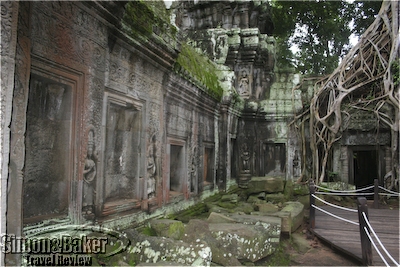
Angkor Wat temple
After exploring the best known and most interesting Angkor Wat temples (sometimes more than once) I longed to see a little more of Siem Reap and its environs. As I was pondering options I mentioned to the hotel manager at my hotel, the Raffles Hotel D’Angkor, my interest in cultural and artistic shops or activities. His suggestions and assistance led me to visit the Golden Silk Pheach farm (see Interesting, inspiring visit to Cambodia golden silk farm), the workshop of Eric Raisina, a Madagascar born and French educated textile designer, and the House of Theam, the shop and art gallery of Lim Muy Theam, a French educated local artist, the following day.
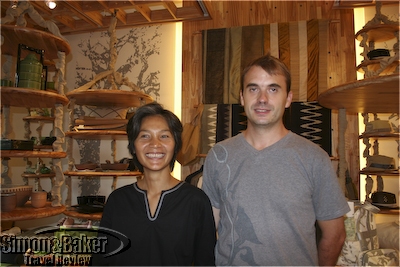
Sirivan Chak and Loic Dumas, owners, Galerie Cambodge
That day at my hotel I browsed the small shopping arcade. While I was enjoying afternoon tea the previous day I met Sirivan Chak and Loic Dumas, two of the three owners of Galerie Cambodge, a clothing and home furnishings store and my favorite shop there. It was distinctive in that unlike many stores in the city selling foreign made goods, 90 percent of the items in the boutique were made in Cambodia. The exceptions were Panama Hats (made in Ecuador) and stunning Burma lacquered bowls made from horse hair and 17 layers of lacquer, requiring six months to complete.

Items for sale at Galerie Cambodge
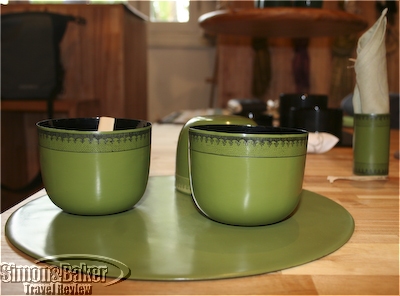
Bowls from Burma, one of my favorite items at Galerie Cambodge
The shop sold housewares, sandals, and casual men’s and women’s handmade clothes with Khmer touches integrated within the chic designs. Prices ranged from $16 for cotton bags to $630 for beautiful and soft golden silk wraps (a favorite). The owners, Nathalie Safon Ridel, an architect, Sirivan, a designer, and her husband Loic, a former production manager in the high tech printing industry, had moved to Siem Reap from Paris, France. I liked their original designs with Cambodian elements and monk-blessed yuoan talismans. I appreciated that they used natural dyes, and natural fibers and followed responsible tourism and fair trade practices, buying products and working with small and family owned producers as well as supporting local non profits. Galerie Cambodge (Raffles Hotel D’Angkor shopping arcade, +855 (0)12 855 204, www.galeriecambodge.com)

Eric Raisina, textile designer and shop owner
Eric Raisina arrived in Siem Reap in 1996 and fell in love with the area. By 2001 he had based his business in the city and by 2004 he had opened his first shop. When I met the silk textile designer he had two shops in Siem Reap and one in Phnom Penh. The villa shop I visited (by appointment only) housed a showroom sandwiched between a workshop on one side, where a half a dozen seamstresses worked on bright and colorful silk fabrics, clothes and accessories, and a dye section on the other.

Silk clothing at the Eric Raisina shop in Siem Reap
“My main focus is really silk because in my country we do have beautiful silk, fantastic and really soft,” said the energetic and tall designer as he walked me around the ground floor showroom and shop in one of the city’s premier residential areas. “I thought this material is really magical.”
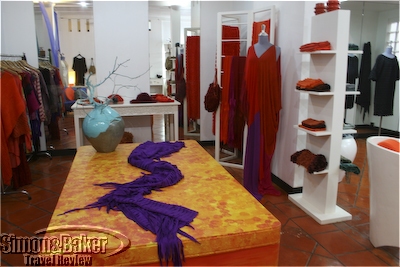
Bright colors and soft silks predominated at Eric Raisina’s shop
What I liked most about his fabrics in addition to the bright colors and whimsical and unexpected textures was the amazing softness of the silk fabrics. Prices ranged between $29 for a scarf to $545 for a travel blanket (my favorite). Villa Boutique Worship (Kot Chork, Siem Reap, Kingdom of Cambodia, +855 (0) 63 963 207, +855 (0)12 580 283 www.ericraisina.com, info@ericraisina.com).
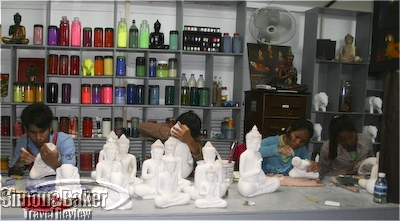
Staff working at the Theam’s House workshop
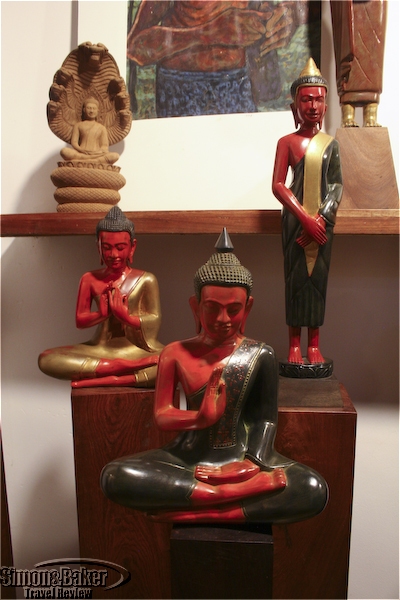
Cambodian art at Theam’s House
I arrived at Theam’s House late in the day, tired, hungry (there had been no time for lunch) and wet from an afternoon of seasonal downpours. Maddy Lim, the Cambodian artist’s sister who had recently quit her job to dedicate her time to the art gallery, welcomed me with a smile. A few moments later she introduced me to Lim Muy Theam, the artist and man behind the shop, and his enthusiasm rubbed off on me. The former artistic director of Artisans d’Angkor had attended the École Boule and the École des Beaux-Arts de Paris before returning to his homeland. He now lived, worked and exhibited his art in the same building. During my visit, he described his artistic style and showed me around the back-of-the-house workshop where his staff were hard at work and the public space where finished artwork was on display.
The gallery was filled with colorful art in varied sizes and shapes. The most distinctive were the oversize acrylic paintings due to be included in the Season of Cambodia exhibit in New York City in 2013. There were also lacquered paintings (starting at $500), bronze and stone sculptures, even cotton scarves from Phnom Srok. The most popular, he said in response to my question, where his souvenir elephants and Buddhas. He was planning on making one thousand Buddhas. Theam’s House (No.25, Phum Veal, Khum Kokchak, Siem Reap Angkor, +855 -0- 12 71 20 39, +855 -0- 78 20 81 61+855 -0- 97 89 855 39, www.theamshouse.com, theamshouse@yahoo.com, info@theamshouse.com)
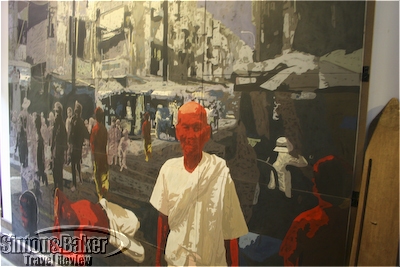
A section of one of the oversize paintings
Late the following morning I took a break from attractions and shopping excursions and scheduled a half day Champagne Spa package at Bodia Spa, a day spa near my hotel. There’s nothing like spa therapy following shopping therapy, I say. The friendly spa ladies spoke English, the spa facilities were quiet (I was the only guest when I arrived) and pretty with water features in a courtyard garden, the treatments were nice and the bubbly, gently chilled, was served with a bowl of fruit. Bodia Spa adjacent to the Heritage Suites Hotel (behind Wat Polanka, + 855 63 762 428, www.bodia-spa.com, contact@bodia-spa.com )
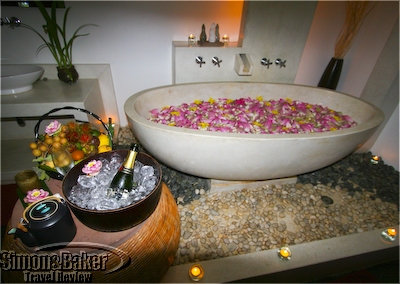
My treatment included a flower filled tub, fresh fruit and a half bottle of champagne
by Editor | Nov 14, 2011 | Luxury Travel
Article and photos by Josette King

The Island Spirit
“How about an Alaska cruise?” a friend suggested as we were discussing potential travel destinations, “I hear the Alexander Archipelago is spectacular.” I dismissed the idea with a reminder that I was not fond of cruises. “Stop holding a grudge,” she laughed, aware that I have been ill disposed toward floating luxury hotels since one of them ruined my gelato break. I was sitting at a canal-side terrace of La Giudecca, the quiet island on the southern side of Venice, when a colossus the size of a city block ponderously glided its way down the canal, obliterating for what seemed an eternity my view of the Laguna and Basilica San Marco.
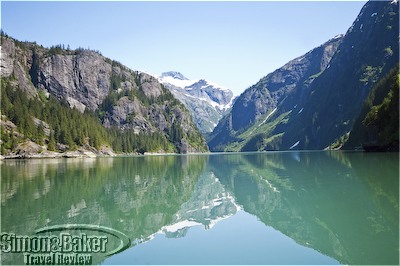
Ford’s Terror mountains were reflected into the cove
But thoughts of the Inside Passage, as the Archipelago is often called, lingered. The 300-mile (500 kilometer) long, 100-mile (160 kilometer) wide area with over 1,000 islands and a labyrinth-like coastline of convoluted channels, deep fjords and active glaciers is considered one of the most stunning wilderness destinations in North America. I thought there had to be a way to get away from the common cruising lanes and meander through its remote reaches. There was.

The fjords abounded with high waterfalls
My nine-day journey on board the Island Spirit was akin to an invitation on the yacht of a friend who liked nothing better than sharing with his guests his passion for the pristine waters and breathtaking scenery of Southern Alaska. With its 25.6-foot (7.8 meter) beam and 7-foot (2.1 meter) draft, the powerful 128-foot (39 meter) long ship was just the right size to wend its way into narrow fjords and idyllic anchorages inaccessible to larger vessels. And with only 17 guest cabins that could accommodate a maximum of 32 passengers and a friendly crew of nine, it offered an intimate environment and laidback atmosphere that greatly enhanced my enjoyment of this exceptional wilderness experience.

Island Spirit captain Jeff Behrens
The ship’s owner and captain, Jeff Behrens, constantly adjusted his loosely defined itinerary to make the most of the ever-changing weather conditions and optimize wildlife sightings while cruising at a relaxed 10 knots per hour along the most sought-after vistas of the Archipelago. We stopped for whales, orcas, porpoises and colonies of sea lions piled up on rocky outcrops. We slowed for seals hitching rides on drifting ice floes. For Captain Jeff, it was not enough to introduce us to narrow fjords framed by dramatic granite cliffs streaked with waterfalls thundering down from snowcapped peaks. He delighted in nudging the ship to the edge of the rock face, close enough that I could feel the icy spray on my face, and reach out to fill a pitcher with the sweetest water I ever tasted.
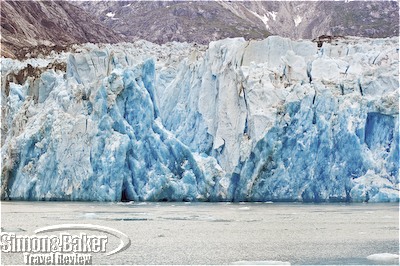
Dawes Glacier
My introduction to a live glacier was a morning long, equally up-close adventure. The ice floes became increasingly larger as we headed up Endicott Arm to Dawes Glacier, until Captain Jeff brought the ship to a stop within a mere 600 feet (200 meters) of a mile-long (1,600 meter) wall of jagged ice about 20 stories high; so close that I could hear the glacier snap. Seconds later, a slab of ice would crash into the water to immediately pop back up as one more iceberg on the already cluttered sea. Time flew as I concentrated on the sounds, challenging myself to guess the location of the next slide.

Alaska sunset
My most treasured memory of this unique cruise is an anchorage known as Ford’s Terror. It is isolated from the outside world by a canyon so narrow, with currents so treacherous that it can be accessed only during slack tide (the moment when currents stand relatively still while the tide turns). The Island Spirit is said to be the only commercial passenger ship around the Inside Passage that is small enough to make its way through. We emerged from the canyon into a stunning oval cove rimmed by steep forests of tall black pines interspersed by tumbling waterfalls. Above the tree line, snowy peaks shone brightly against the cloudless cerulean sky. But the magic of Ford’s Terror went far beyond its breathtaking scenery. As we were finishing our dinner, Andy, the first mate, informed us that a grizzly bear was enjoying his at the water’s edge. One of the skiffs was lowered for those who wanted a closer look. We reached en masse for our life vests and headed for the skiff. By the time we returned to the ship an hour later, a perfect crescent moon was rising into the still pale blue sky.
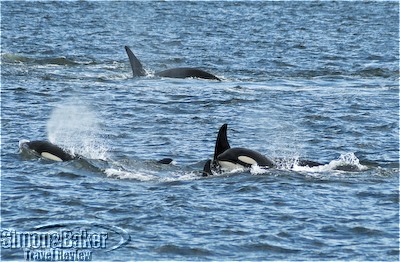
Orca whales frolicked by our ship
The weather was again radiant the next morning. While kayaks were an option, I chose to board the skiff again for a ride around the cove. In addition to spotting unusual Harlequin sea ducks and bald eagles nesting high in the trees, I was treated to a rare, close range sighting of a black bear sow and her three tiny cubs. Visit the Simon & Baker Travel Review to read more about my Alaska cruise on board the Island Spirit.
by Editor | Oct 31, 2011 | Accomodations, Ecotourism, Luxury Travel
By Elena del Valle and photos by Gary Cox
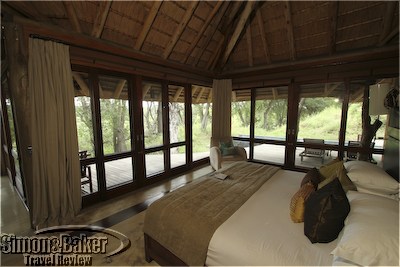
Suite 2 at Leadwood looked out into the bush
During a visit to South Africa’s famous Sabi Sand Reserve earlier this year we stayed at three &Beyond properties, Dulini and Leadwood at the Exeter Reserve and Kirkman’s Kamp on the southeastern corner bordering http://simonandbaker.com/kruger. While each had a charm of its own, Leadwood was the most intimate and luxurious, our favorite. One of the reasons it captured our hearts, in addition to fine suites with private plunge pools, contemporary stylish décor, an emphasis on privacy and top notch service and meals, was the informal presence of art.
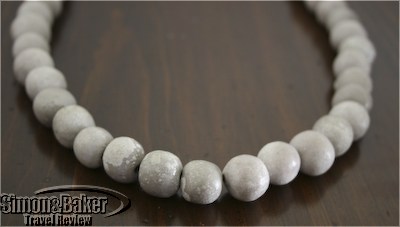
A necklace created by Gift
Three of the staff pursued artistic inspiration in their free time. We found out quite by coincidence and asked to see their work. Shyly, each in turn, displayed examples of his or her efforts. Gift Nyulunga, one of the cooks, made simple bead necklaces out of recycled glass. The large-bead necklaces were available in a limited variety of colors and lengths and were quite affordable starting at about $10.
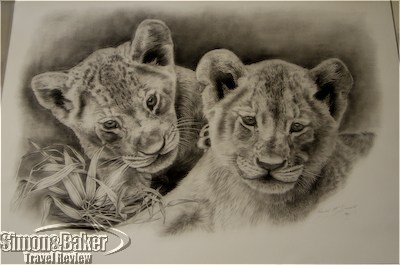
One of Andre McDonald’s drawings of lion cubs
Andre Mc Donald, or “Mac” as everyone knew him, our affable guide, drew beautiful lifelike wildlife drawings of the animals in the reserve. The Cape Town native who grew up in the Eastern Cape had been selling his art for five years. We had no idea of his hobby and it was only when I overheard someone comment about his work, and after asking several times, that he brought a handful for us to see one afternoon before tea.
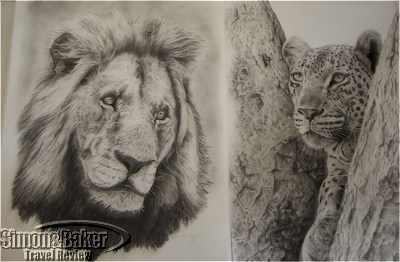
Mac’s lion and leopard detailed drawings
“I have had no formal training in art but have always had a keen interest in drawing,” said Mc Donald. “After school I did not draw for many years until I started to work as a ranger on a private game reserve where I began to sketch wildlife. After seeing some of my earlier work, one of my guests encouraged me to develop my skill further.”
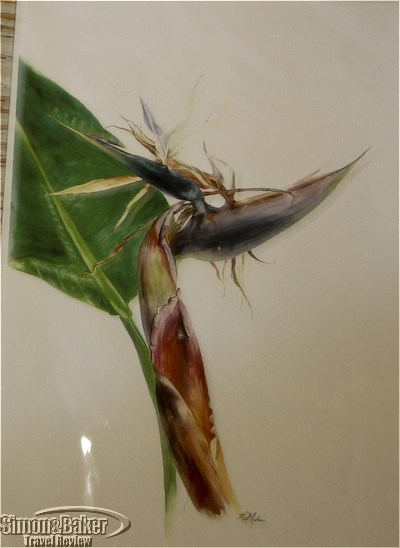
A watercolor by Kerry Michau
His goal is to sketch very realistic representations, in terms of the proportions and postures, of the animals he and his guests often see on the game drives, especially leopards and lions. Each spot on a leopard, for example, is drawn with at least three different pencils to get the depth and texture of the fur just right, he explained.
“I draw from photographs which means that each drawing is true to the original animal. Because I know the animals I draw, I try to capture the character of each individual, in particular the look in their eyes. I look for photographs with an interesting pose or setting.”
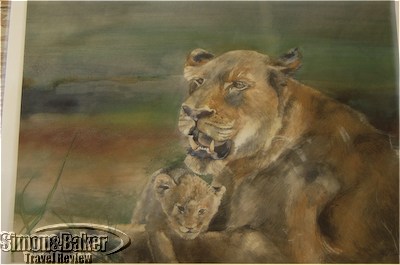
Lion and cub in watercolor
Mac’s pencil drawings had found homes in 22 countries, including United States, Germany, Dominican Republic, Malta, New Zealand and France. The limited edition prints (98 of each) sold for $220 each; originals for $1,000 or $1,500. Overseas delivery required two weeks. He could be reached by email at keriann.mcdonald@gmail.com
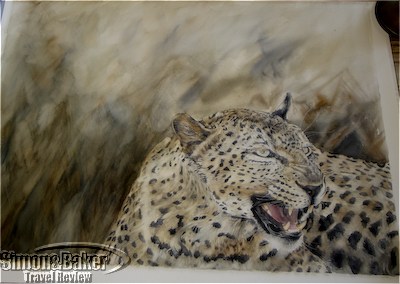
Leopard by Kelly Michau
Kerry Michau, the part time assistant manager, was the third artist. She worked with watercolors, painting the wildlife in the reserve as well as modern abstract pieces and fashion.
For more information about Dulini, Leadwood and Kirkman’s Kamp and other luxury properties in that area visit the Sabi Sand Reserve section of the Simon & Baker Travel Review.
by Editor | Sep 26, 2011 | Luxury Travel
Article and photos by Josette King
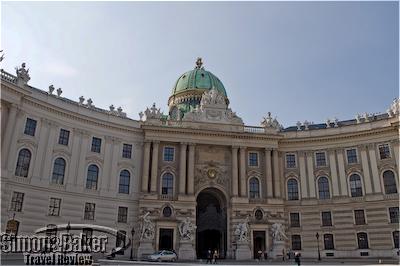
Main façade of the Hofburg imperial palace in Vienna
There is always a risk in revisiting best-loved places that they may have changed. My first encounter with Vienna dates back to the 1960’s. The shine of the once brilliant capital of the Habsburg Dynasty had been dulled by the aftermath of two world wars; but even so, it had managed to retain enough of its past grandeur and courtly traditions to seduce me on the spot. I returned several times over the ensuing decades and with each visit, I delighted in observing an accelerating pace of renaissance. Palaces were restored to their imperial majesty; and in the center of town, new constructions were sensitively integrated into their historic surroundings; Vienna has indeed changed over the recent past, but only for the better. Today it is again a sparkling jewel in the center of Europe, the 21st century version of the exuberantly luxurious and romantic capital of its imperial heydays.
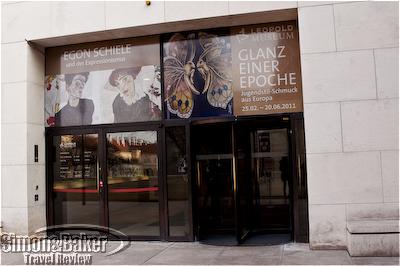
The Leopold Museum
I hadn’t been back in over a decade, so the intent of my recent visit was to catch up with this new, 21st century Vienna and more specifically visit the Leopold Museum. Opened in 2001 to hold the previously private art collection of Rudolph and Elizabeth Leopold, it is a treasure trove of Austrian Modernist masterpieces, including the world’s largest collection of the works of Egon Schiele, recognized as one of the greatest figurative painters of the early 20th century. Although he died at the age of 29 in 1918, Schiele left an amazing body of work that had been all but forgotten until local art collector Rudolph Leopold rediscovered him in the 1950. Today 330 of his oil canvases and over 2,500 of his drawings are part of the Leopold’s collection. Many of his major works are permanently on display along with a number of paintings by Gustav Klimt, Oskar Kokoschka and other leading artists of the Austrian Modernism movement. The museum also includes a stunning collection of Art Nouveau jewelry and crafts.
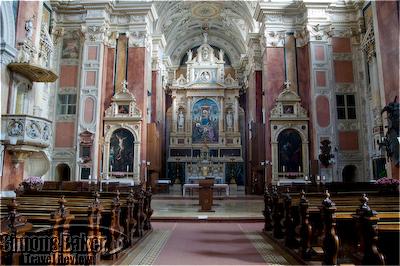
Baroque churches abound in Vienna
Another exciting discovery was the extensive renovation work that had been completed on the Kärntner Ring section of the Ringstrasse (or simply the Ring), the broad 19th century boulevard that circles the center of the city. At the time of its construction, the Ring had been lined with palaces, public buildings and several landmark hotels. Some of the latter had over time fallen into serious disrepair, some to the point of being boarded up for a time. Since my last visit, two of these hotels, the Grand Hotel Wien and the Ring Hotel had been restored to their original splendor.
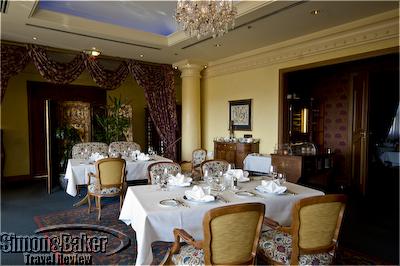
Le Ciel dining room at Grand Hotel Wein
Behind its superb classic facade, the Grand Hotel Wien, the first luxury hotel in the city when it first opened its doors in 1870, once again welcomed its guests to palatial interior spaces, Viennese Grand Style décor and the impeccable service that spoke of the opulence of a bygone area. Meanwhile just across the street, the Ring Hotel, once a residential property that had provided in-town pieds-à-terre for bachelors of the Viennese aristocracy, had undergone a complete interior reconstruction. It had re-opened in 2007 as a contemporary luxury hotel appointed with the latest amenities, including a state-of-the-art health club and spa tucked under the eaves, and a sauna with a glorious view over the rooftops of the city. It was a perfect place to enjoy some of the best of contemporary Vienna within a few minutes’ walk from the significant historic and artistic landmarks in the city. Visit the Simon & Baker Travel Review to read more about my recent visit to Austria, the Grand Hotel Wien and the Ring Hotel.
by Editor | Sep 19, 2011 | Luxury Travel
Article and photos by Josette King
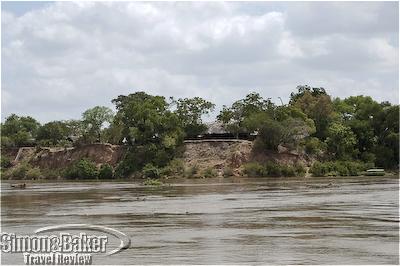
Rufiji River Camp was stretched high on a bluff
After a visit to Katavi in the farthest reaches of western Tanzania, I flew to the Selous Game Reserve. It was a long way back east from Katavi to Selous, several hours including a stop-over in Ruaha, which gave me time to collect myself and re-enter the 21st century. Located in southeast Tanzania, the Selous Game Reserve covers more than five percent of Tanzania’s total landmass. It is the largest protected and one of the oldest wildlife reserves in Africa. It was first established over a century ago as a hunting reserve, and large portions to the south of the Rufiji River are still set aside for hunting, while the northeastern part of Selous is dedicated to photographic tourism.

The river was filled with hippos
The remote location limits the number of visitors, although I found Selous to be relatively more crowded than anywhere else I visited in the Southern Circuit. In addition to being home to the Rufiji River and to its remarkable abundance of game and bird life, what made Selous unique was its status as a game reserve. It permitted a larger range of activities than in the more regulated national parks.
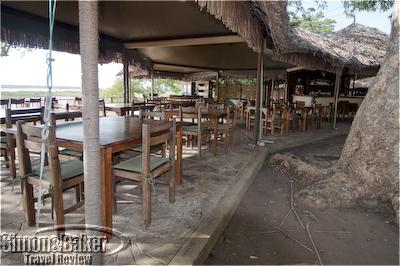
The dining area at Rufiji
The Rufiji River Camp made the most of this advantage. Stretched along a bluff overlooking the river, the camp delivered an outstanding variety of game viewing activities. Game drives in the camp’s open-sided vehicles were especially rewarding as it was possible to go off-road for optimum viewing. The camp also offered river safaris in open-sided pontoon boats, and walking safaris. A favorite activity of mine was the siesta time armchair safaris I enjoyed on my private veranda which overlooked an active pod of hippos and the riverbank where elephants came to drink and crocodiles lazed in the sun. Meanwhile every rustle in the trees above my tent was a new birding opportunity.

A thatched roof shaded the bell-shaped pool
Visit the Simon & Baker Travel Review for more about my recent visit to Tanzania and the Rufiji River Camp.
by Editor | Sep 6, 2011 | Luxury Travel
Article and photos by Josette King

My suite overlooked the river and the mountain
I recently came upon Shangri La, crash landing in a lost Himalayan valley not required. My own Utopian mountain paradise was much more readily accessible. Nestled in a pristine valley between the Grossglockner (the highest Alpine peak in Austria) and the Dolomites, the tiny medieval town of Lienz was only a few hours away from Vienna, or Venice. Just a few minutes walk from the center of town along the crystalline waters of the Isel River, the last glacial stream in the Alps, the Grandhotel Lienz was a cocoon of luxury where time and the aging process felt suspended. Although I visited during an exceptionally frigid winter spell, any climactic or indeed, any exterior world consideration faded into irrelevance the instant I entered the lovely white stone mansion-like property.

Reception foyer
The inclement weather was a welcome opportunity to linger longer in front of the dancing fire in the lounge; or enjoy the wintery views and crisp mountain air while dreamily floating around the huge heated outdoor whirlpool. What I liked best of all was to lose myself in the stunning two-level spa, with its multiple saunas and steam rooms, serene relaxation lounge and sophisticated treatment rooms where a staff of expert therapists offered a full range of superb massages and spa treatments.

Orangerie dining room
The gourmet restaurant, with its sumptuous breakfasts and imaginative daily degustation dinner menu was further enticement never to leave the premises. As was my exquisite suite with its vases filled with fresh flowers, Nespresso coffee machine, and the oversize chaise thoughtfully angled to offer an equally enjoyable perspective of the mountain and the large LCD television screen.

Lounge and bar
For those less slothfully inclined, Lienz was rich in natural and historical resources, with a 13th century castle just at the edge of town, and well preserved frescoes within its ancient churches. For the hardier souls, superb skiing awaited, with lifts right in the center of town to transport them up to the top of well-groomed, uncrowded slopes. Looking at the spectacular vistas that surrounded the area, it was easy to understand that this was prime four-season vacationing country, and a bucolic retreat where I would enjoy returning any season of the year.
Visit the Simon & Baker Travel Review to read more about my visit to Austria and Grandhotel Lienz.












































